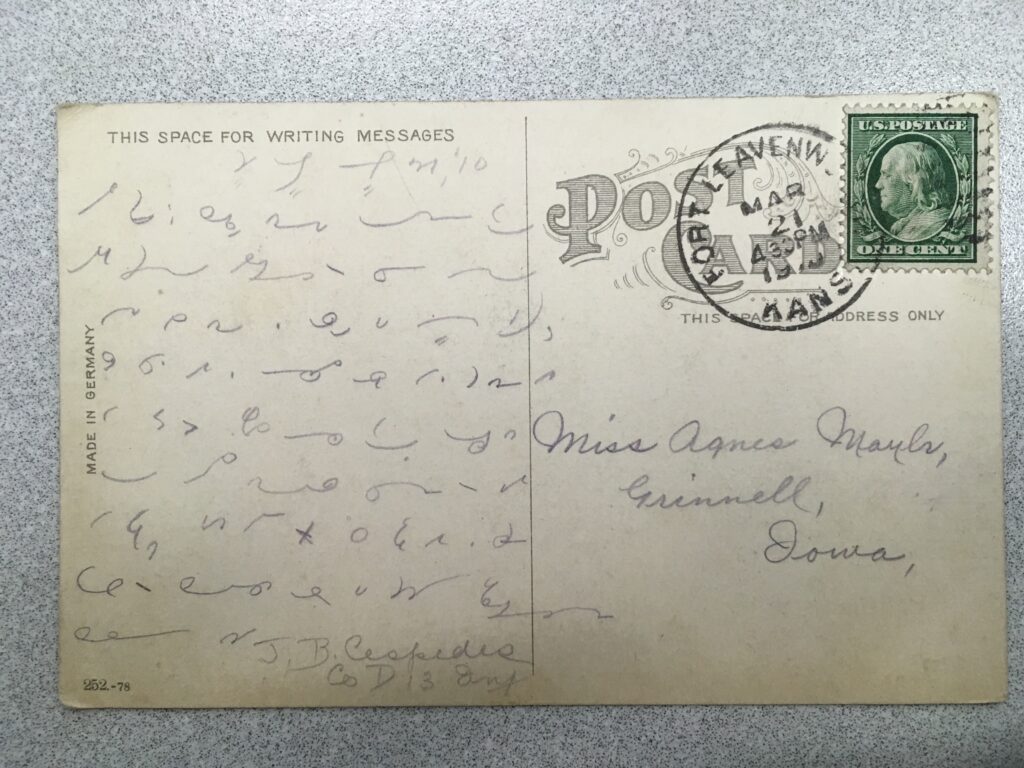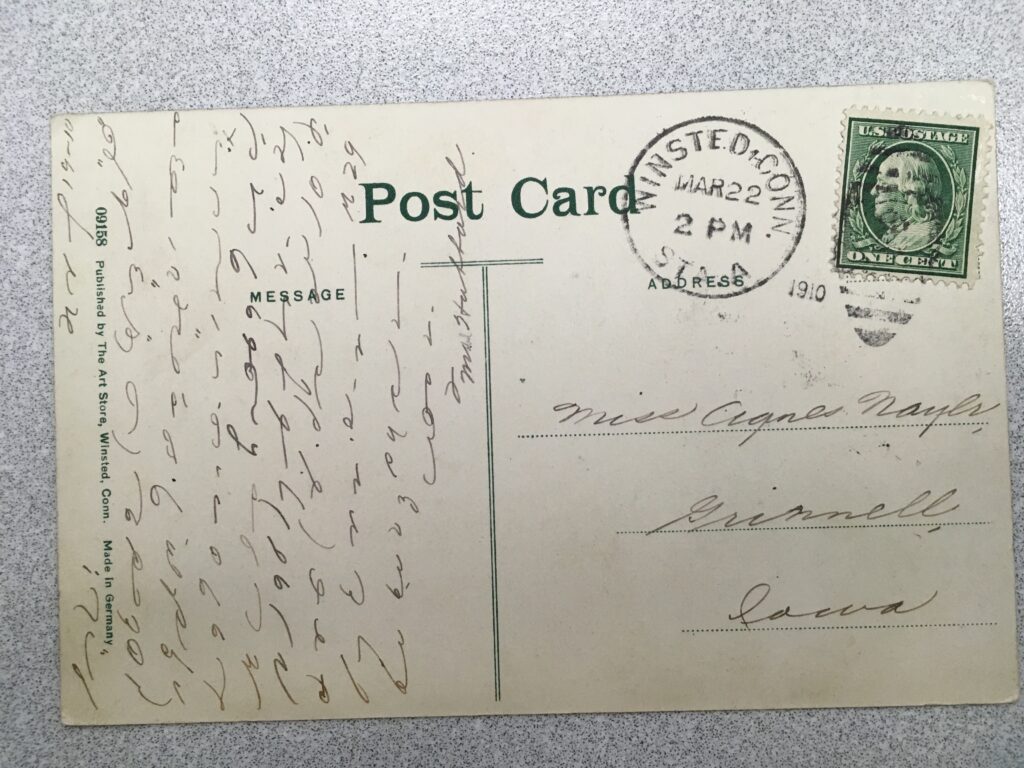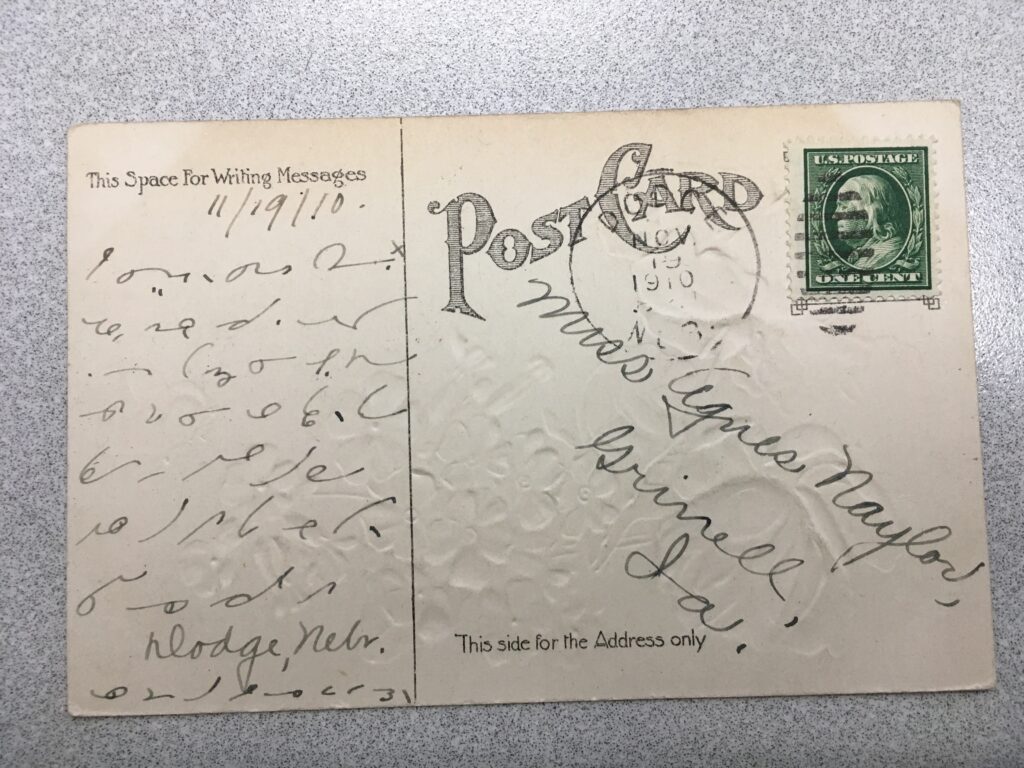Keeping Secrets? Messages in Shorthand on Postcards
Last post introduced Clara Stahl and Agnes Naylor, two stenographers in Grinnell, Iowa, in the early twentieth century. Both collected postcards, and agreed to exchange cards (i.e. send them to each other) to help increase their respective collections. We know this thanks to a typewritten card Clara sent to Agnes.
Typewritten cards offered highly legible messages for recipients to read. (Typewritten messages are also much appreciated by many historians.) Clara clearly didn’t mind anyone and everyone reading that message. Nor did she likely worry about messages she composed in handwritten English. After all, the very nature of postcards meant anyone who got their hands on one–such as a postal worker sorting them and/or delivering them–could read the contents if they wished. Much less secret than sealed letters, if cheaper to send.
Sometimes, however, senders chose to try and conceal the contents of their messages–while inscribing them on postcards. People fluent in more than one language might use languages other than whatever was the dominant tongue in the area, although they still ran the risk of the card falling into the hands of someone who also read the language in question.
Clara likely spoke or understood some German, since her parents had emigrated from Germany. Agnes may have as well, although her parents were born in North Carolina. Regardless, they had an alternative way to communicate while reducing the odds of anyone understanding what they wrote. They were both stenographers and could read and write shorthand. True, many others also read shorthand–but their numbers were far less than the population at large.
Indeed, over the year 1910 Agnes received several postcards in shorthand. At least four arrived in the first half of the year (in May or March). Maybe she was in correspondence with other stenographers or attended a convention of some sort (or recently graduated from school?) and they had an agreement to exchange cards. Or they may even have been part of some postcard club, given the variety of places from which they sent the cards. The last (of those I have) arrived in November.


![Stamp. Postmark Hartford[?] City Indiana, 25 April 1910. Message in shorthand, signed Ruth Chandler.](https://aleahenle.com/wp-content/uploads/2020/11/IMG_3254-1-1024x768.jpg)
![Stamp. Postmark [Hartford?] city, Indiana. 23 May 1910. Message in shorthand, as is signature.](https://aleahenle.com/wp-content/uploads/2020/11/IMG_3252-1-1024x768.jpg)

I don’t read shorthand. Although I have plans to someday arrange for these to be transcribed, when is an open question. Therefore, I can’t tell you what information they chose to entrust to the mail and whether they used shorthand for fun, convenience, or to increase the odds of secrecy. At this time, your guess is as good as mine–unless you read shorthand in which case it’s likely better!
These cards are worth highlighting–but the majority of cards I’ve collected are not in any kind of shorthand or code (though check in next post for another exception). People wrote about things they didn’t mind others potentially reading, or expected no one else would find of much interest.
Agnes and the rest of the Naylors are an interesting crew, based on the postcards in my possession. It’s unlikely I’ll share any more here in the immediate future. Most of the next year will focus on a different batch of cards. Nevertheless, I’m going to dwell a little longer on the Naylors and their cards. As mentioned in my previous post, these helped hook me into collecting batches of postcards sent to the same person.
Of the cards I gathered that were sent to the Naylors and saved in Agnes’s collection (and/or that of one of her other sisters) many were also sent by Naylors. One of Agnes’s oldest sisters, Verta, (confusingly, she also had an older sister Vera) was a Methodist missionary who sent postcards back to Agnes to contribute to her sister’s collection while also helping ensure her family knew where she was, for Verta moved around quite a bit. Another sister, Ada or Adah, spent time working in Davenport, Iowa, and at the Cunningham Children’s House, an orphanage in Urbana, Illinois; several of the postcards were addressed to her. One of Agnes’s brothers, Raymond, married a woman, Nettie, who regularly sent postcards updates from her, her husband, and their baby. Another brother married a woman named Ada who evidently had tuberculosis and spent time in the Oakdale Sanitorium and sent back some very colorful postcards describing the medical treatments and her interactions with the doctors.
The Naylor family points to the importance of external research in working with collections. Although Agnes’s sister used Adah more often than Ada, at first glance her handwriting and that of her sister-in-law Ada (who sometimes, but not always, signed herself as Ada N.) is not dissimilar. I studied them pretty closely to decide who’d written which.
But enough teasing. Anyone who reads these posts will be exposed soon enough to some of the joys and frustrations of working through batches of postcards sent to the same individual, and often from the same individual. Two more posts on interesting cards from my assortment, and then we start to dig through a single album.
